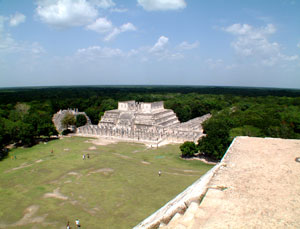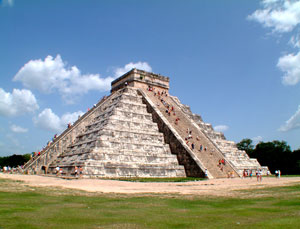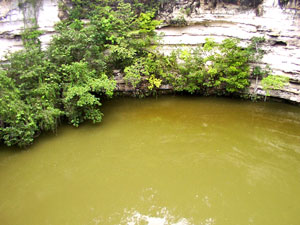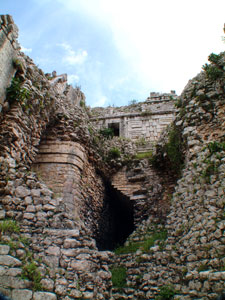Edward Herbert Thompson: Explorer Extraordinaire of the Yucatan
by Jeanine Lee Kitchel
Few archeological explorers can live up to the image of Edward Herbert Thompson. Most famous for dredging Chichen Itza’s sacred cenote in 1904, Thompson’s exploits were pure textbook archeology—Yucatan adventuring at its very finest.
Born in Worcester, Massachusetts on September 28, 1856, Thompson followed in the footsteps of the Yucatan’s first known explorers John Lloyd Stephens and Frederick Catherwood, author and artist of Incidents of Travel in Yucatan. Shortly after publication of this instant bestseller in 1843, the Caste War of the Yucatan broke out (1847) limiting access to many of the Yucatan’s finest ruins. The Caste War closed Yucatan and Quintana Roo borders to all but indigenous Maya for nearly 60 years, making travel to the area downright dangerous.
Thompson, appointed archeological consul to the Yucatan in 1895, was one of the first explorers to tread the land after the Caste War began. Although he never received formal training in anthropology, geology nor any other related discipline, Thompson’s work as anthropologist began in 1879 when he published his thoughts on the Maya culture in a highly unscientific article he wrote for Popular Science Magazine. Titled “Atlantis: Not a Myth,” Thompson attempted to link Socrates’ lost continent with the rediscovered Maya. Although he later disclaimed his theory, Thompson felt the article gained him the notoriety he needed to attract the attention of Vice President of the American Antiquarian Society, Stephen Salisbury, Jr., an avid student of Maya culture. In 1885 Salisbury chose Thompson to become a scientific investigator of the ruins on the Yucatan Peninsula. One of Salisbury’s influential friends, U.S. Senator George Hoar, asked the president of the United States to appoint Thompson American consul to Mexico.
As the youngest consul ever, Thompson’s post would be the Mexican states of Yucatan and Campeche, and he would use this post as a base from which to explore the ruins. With his wife, the former Henrietta Hamblin, daughter of a retired whaling captain, and their two month old daughter, Thompson headed south in 1895.
He passed his first several months in Yucatan’s capital, Merida. He began the slow process of getting acquainted, believing the best way to learn about the Maya was to befriend them, study their legends and psychology, and master the language, in which he succeeded beautifully. He traveled widely in those early months, trekking to all the known ancient cities and temple sites (well over 100) to familiarize himself with the ruins and the lay of the land. Unlike many of his more schooled counterparts, Thompson learned to travel light and live on what he termed “Indian food” which gave him a distinct advantage over those of his colleagues who refused to “go native” as Thompson had done.
So firmly was Thompson embraced by his new world that he was initiated into a Maya secret society, the Sh’ Tol Brothers, who honored him by making him custodian of their sacred drum. In the Temple of the Jaguar at Chichen Itza, a bas relief depicts the dance known by tradition as the dance of the Sh’Tols.
Although Thompson’s adventures would leave an indelible physical mark on the man (he was lame in one leg after an encounter with a poison trap while riding through the Yucatan forest) his archeological fame soared. He was known for two coups -- his first was the purchase of Chichen Itza, through the auspices of Allison Armour, Chicago meat packing magnate. In 1890, Armour made a donation to Thompson intended for purchasing the ruins at Chichen Itza.
With $75 U.S., Thompson acquired 100 square miles of land on which the ruins were located along with a Spanish plantation house which he used as his headquarters. While waiting for the plantation house to be rebuilt (now Hacienda Chichen Hotel), the eastern end of Chichen Itza’s Nunnery served as Thompson’s dormitory.
But the height of Thompson’s archeological fame came from his dredging of the cenote at Chichen Itza in 1904. From his first excursion to Chichen Itza, Thompson admitted he had an uncanny draw to the sacred cenote. In his book People of the Serpent, published in 1932 just three years before his death, Thompson admitted the cenote had “beckoned” to him when he first stood atop El Castillo and gazed down at the grove of trees that surrounded it. This initial interest spurred him on to read any and all texts and documents he could find relating to the Maya. As all but three of the Maya codices (paperbark books) had been destroyed by fire by Bishop Diego De Landa in the early 1500s, little information on the early Maya existed.
After De Landa destroyed the Mayan’s written language along with countless statues and religious paraphernalia, the King of Spain ordered De Landa to write a history of the Maya people and their culture. Thompson read the bishop’s account of the sacred well at Chichen Itza which detailed that during times of drought or disaster, processions of priests and commoners made pilgrimages to the cenote in hopes of appeasing the gods who they believed lived in the cenote’s depths. De Landa’s account stated that maidens and captive warriors were thrown into the well as human sacrifices. Afterwards, it was customary for the commoners to throw in ornaments, household items, and gold.
Thompson took De Landa’s written account as factual and went to great measures to discover what was at the bottom of the cenote. To implement his plan, he realized he would have to develop a diving apparatus. The explorer headed back to the U.S. and gathered funds from friends, then went to Boston where he took deep sea diving lessons for two months. While in Boston, he adapted a dredging bucket, winch, tackles, steel cables, a derrick, and a 30-foot swinging boom for his cenote project. He had it all crated and shipped south.
A few weeks later Thompson was back on Yucatan soil, training local Mayans to assist him in what everyone considered to be a maniac’s misadventure. For nearly a month, after fashioning the materials to fit his needs, he dredged through thick silt, coming up empty day after day. Then finally he pulled up a mucky yellow substance which he could not recognize. His instinct told him it had worth. Luckily he dried it out and attempted to burn it.
It was a Mayan incense, copal, and with this discovery, he knew he was on the brink of a major finding. Two days later, his efforts were rewarded. Piece after piece of the long-awaited treasure was dredged up. Thompson had succeeded and was bringing forth vases, ornaments, and obsidian knives. But the large bucket on his dredging equipment kept dropping items, and he knew to truly search the cenote he would have to take the dive himself. While in the U.S., Thompson had been introduced to a Greek diver from the Bahamas. He enlisted the man’s talents, and two weeks later they had rigged up outfits of waterproof canvas with 30-pound copper helmets and plate glass goggles and air valves. He and the Greek dove into the cenote and discovered amazing treasures. In the days and weeks that followed, they pulled up figures representing Mayan gods, gold and copper discs, jade stones, and human skeletons.
In the outside world, Thompson’s find at the sacred cenote at Chichen Itza was rivaled only by the discovery of King Tut’s tomb. Thompson had put the Maya back on the explorer’s map. Although he didn’t have the gold that Tut‘s tomb had uncovered, Thompson had proof that human sacrifices had been made at Chichen Itza. Young women had been hurled into a dismal pool by fanatical priests as offerings to their gods. And the explorer had dredged up their skeletal remains to prove it.
Ironically Thompson’s score threatened to jeopardize his standing in the archeological community as it was later discovered many of the artifacts he’d dredged had been secretly sent back to the Peabody Museum in Boston in diplomatic pouches where most remain to this day, far from the Yucatan. But such was Thompson‘s stature that even this revelation did not diminish his professional standing.
Thompson also discovered how the Maya built the pyramids. Near Chichen Itza he found shallow quarries with worked veins of sascab, the lime gravel mixture the Maya used as mortar. Scattered around the area he found hammer stones of calcite, pecking stones of flint, and smoothing stones that were no doubt used to produce flat surfaces on walls. Even though the ancient Maya craftsmen had no metal tools, Thompson’s discovery of this quarry assisted scientists in determining how the Maya created their pyramids without the use of metal. Thompson also found chisels of Nephrite and as a test, he used one to carve his own name onto an ancient stone to prove it could be done. Thompson went on to discover an ancient Maya ‘date’ stone, later named the Tablet of the Initial Series, which served in deciphering dates of Chichen Itza by later cryptologists.
Thompson’s exploits were those of an intrepid explorer. His continued determination throughout his 40-year tenure in the Yucatan helped unravel the secrets of a great civilization.
(This is the first in a series titled Explorers of the Yucatan. Jeanine Lee Kitchel lives in Puerto Morelos. Her nonfiction travel adventure, Where the Sky is Born: Living in the Land of the Maya, is available through amazon.com or local bookstores. Contact Jeanine at .





